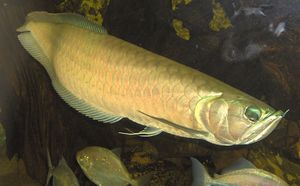أشباه عظمية اللسان
| Osteoglossiformes | |
|---|---|

| |
| Osteoglossum bicirrhosum | |
| التصنيف العلمي | |
| أصنوفة غير معروفة (أصلحها): | Osteoglossiformes |
| Type species | |
| Osteoglossum bicirrhosum | |
| Families | |
| |
| Synonyms | |
| |
Osteoglossiformes /ˌɒstiːoʊˈɡlɒsɪfɔːrmiːz/ (Greek: "bony tongues") is a relatively primitive order of ray-finned fish that contains two sub-orders, the Osteoglossoidei and the Notopteroidei. All of at least 245 living species inhabit freshwater. They are found in South America, Africa, Australia and southern Asia, having first evolved in Gondwana before that continent broke up.[2] In 2008, several new species of marine osteoglossiforms were described from the Danish Eocene Fur Formation, dramatically increasing the diversity of this group. This implies that the Osteoglossomorpha is not a primary freshwater fish group with the osteoglossiforms having a typical Gondwana distribution.[3]
The Gymnarchidae (the only species being Gymnarchus niloticus, the African knifefish[4]) and the Mormyridae[5] are weakly electric fish able to sense their prey using electric fields.
The mooneyes (Hiodontidae) are often classified here, but may also be placed in a separate order, Hiodontiformes.
Members of the order are notable for having toothed or bony tongues, and for having the forward part of the gastrointestinal tract pass to the left of the oesophagus and stomach (for all other fish it passes to the right). In other respects, osteoglossiform fishes vary considerably in size and form; the smallest is Pollimyrus castelnaui, at just 2 سنتيمتر (0.79 in) long, while the largest, the arapaima (Arapaima gigas), reaches as much as 2.5 متر (8.2 ft).[2]
السلالة
Phylogeny based on the following works:[6][7][8]
| Osteoglossiformes |
| ||||||||||||||||||||||||
References
- ^ قالب:FishBase order
- ^ أ ب Greenwood, P.H. & Wilson, M.V. (1998). Paxton, J.R. & Eschmeyer, W.N. (eds.). Encyclopedia of Fishes. San Diego: Academic Press. pp. 81–84. ISBN 0-12-547665-5.
- ^ Bonde, N., 2008: Osteoglossomorphs of the marine Lower Eocene of Denmark – with remarks on other Eocene taxa and their importance for palaeobiogeography. Geological Society, London, Special Publications; 2008; v. 295; p. 253-310
- ^ Froese, Rainer; Pauly, Daniel (eds.) (2014). "Gymnarchus niloticus" in FishBase. April 2014 version.
- ^ Greenwood, P.H. & Wilson, M.V. (1998). Paxton, J.R. & Eschmeyer, W.N. (eds.). Encyclopedia of Fishes. San Diego: Academic Press. p. 84. ISBN 0-12-547665-5.
- ^ Betancur-Rodriguez, R.; et al. (2016). "Phylogenetic Classification of Bony Fishes Version 4". Deepfin. Retrieved 30 December 2016.
- ^ Lavoué, S., Sullivan J. P., & Hopkins C. D. (2003): Phylogenetic utility of the first two introns of the S7 ribosomal protein gene in African electric fishes (Mormyroidea: Teleostei) and congruence with other molecular markers. Biological Journal of the Linnean Society. 78, 273-292. PDF Archived 2014-10-30 at the Wayback Machine
- ^ Sullivan, J. P., Lavoué S., & Hopkins C. D. (2000): Molecular systematics of the African electric fishes (Mormyroidea: Teleostei) and a model for the evolution of their electric organs. Journal of Experimental Biology. 203, 665-683. PDF Archived 2014-10-30 at the Wayback Machine
External links
- Osteoglossiforms for aquaria
- Li, Guo-Qing and Wilson, Mark V. H. 1998. Osteoglossomorpha. Bonytongues. Version 6 October 1998. [1] in The Tree of Life Web Project
- Sepkoski, Jack (2002). "A compendium of fossil marine animal genera". Bulletins of American Paleontology. 364: 560. Retrieved 2011-05-17.